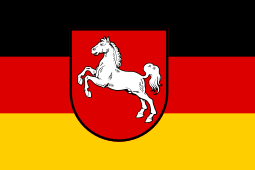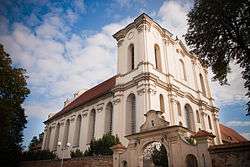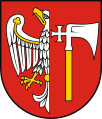Wągrowiec
| Wągrowiec | |||
|---|---|---|---|
|
Cistercian monastery | |||
| |||
 Wągrowiec | |||
| Coordinates: 52°48′N 17°12′E / 52.800°N 17.200°E | |||
| Country |
| ||
| Voivodeship | Greater Poland | ||
| County | Wągrowiec County | ||
| Gmina | Wągrowiec (urban gmina) | ||
| Town rights | 1381 | ||
| Government | |||
| • Mayor | Stanisław Wilczyński | ||
| Area | |||
| • Total | 17.91 km2 (6.92 sq mi) | ||
| Population (2006) | |||
| • Total | 24,681 | ||
| • Density | 1,400/km2 (3,600/sq mi) | ||
| Time zone | CET (UTC+1) | ||
| • Summer (DST) | CEST (UTC+2) | ||
| Postal code | 62-100 | ||
| Area code(s) | +48 67 | ||
| Car plates | PWA | ||
| Website | http://www.wagrowiec.eu | ||
Wągrowiec [vɔŋˈɡrɔvjɛt͡s] is a town in northwestern Poland, 50 kilometres (31 miles) from both Poznań and Bydgoszcz. Since the 18th century it has been the a seat of a powiat. It is currently attached to the Greater Poland Voivodeship. The town is situated in the middle of the historical region of Pałuki and the Chodzież lake area (Pojezierze chodzieskie), on the river Wełna and its tributaries Nielba and Struga, as well as on the shores of Durów Lake.
Geography
The region around the town is rich in lakes. The town itself sits in the middle of Lake Durowskie (jezioro durowskie]. The Wągrowiec municipal area boasts a rare attraction: two rivers, the Nielba and Wełna cross there, without commingling.
Administration
Wągrowiec is constituted as a gmina miejska, or municipal commune. The city is also the seat of the rural commune of Wągrowiec, as well as of powiat of Wągrowiec.
Situated in the Greater Poland Voivodeship since 1999, Wągrowiec was previously a part of the Pila Voivodeship (1975–1998).
Economy
Wągrowiec is an important rail and road junction. There are several notable industries in the town, including the machinery factories (a branch of the Hipolit Cegielski factory in Poznań and a branch of the Zremb machinery factory), major food processing plants (a mill, meat canning factory and a milk yard) and a furniture factory. The town is also a centre of tourism, with several hotels along the shores of the lake.
History
The town was founded as a small village called Prostynie by the Cistercian monks from the monastery in Łekno in 1319. In 1381 the name of Wągrowiec is mentioned for the first time in connection with the place. By that time the town received city laws, most likely modelled after the Magdeburg Law. At the end of the 16th century, King Władysław Jagiello gave the city the privileges of market and fair, and in 1396 the Cistercian monastery was moved in.
The town soon started to prosper. In the 15th and 16th centuries it was an important centre of trade, commerce, and manufacture (mostly textiles). This prosperity came to a halt during the Deluge, when in 1656 the town was captured, pillaged and burnt by the forces of Charles X of Sweden.
After the Partitions of Poland, Wągrowiec in 1793 was annexed by Kingdom of Prussia and was confiscated from the Cistercians in 1797. Initially a part of the newly created province of South Prussia, it was in 1807 transferred to the Duchy of Warsaw, a state allied to the Napoleonic France.
After Napoleon's defeat and the Congress of Vienna in 1815, Wągrowiec was again annexed by Prussia; this time it was made a part of the autonomous Grand Duchy of Poznań.
In 1835 the Cistercian monastic order was dissolved, and its property was confiscated by the Prussian authorities. On February 9, 1849, the autonomy of the Duchy was cancelled, and Wągrowiec — under the Germanized name of Wongrowitz — became part of the Province of Posen. In 1888 a railroad line linking Wągrowiec with Poznań was opened.
After World War I, Wągrowiec found itself again within the borders of a Polish state, the Republic of Poland. This did not happen without a struggle, though: in the years 1918-19 Polish inhabitants of Wągrowiec fought in the Greater Poland Uprising. The local populace had to acquire Polish citizenship or leave the country. This led to a significant decline of ethnic Germans, whose number within the district decreased from 16,309 in 1910 to 8,401 in 1926 and further to 7,143 in 1934.[1]
Following the Molotov-Ribbentrop Pact and the end of the Polish Defence War of 1939, the town was annexed to the German Reich. During World War II, Wągrowiec was part of the German Reichsgau Wartheland and its name was changed by the Nazis to Eichenbrück. Many of its Polish inhabitants were expelled to the more easterly areas of the General Government as part of the implementation of 'Lebensraum' policies. Wągrowiec was liberated in January 1945 and the expelled Polish inhabitants returned.
Miscellaney
Notable people from Wągrowiec
- Jakub Wujek, author of a translation of the Holy Bible into the Polish language, was born in the town (1541).
- Adam of Wągrowiec, organist and composer was a Cistercian monk in town, died (1629)
- Max Gerson, (1881 - 1959), German physician
- Stephan Rittau (1891 – 1942), Wehrmacht general
- Fritz Steuben (1898 – 1981), German author
Notable architecture and other attractions
- The Gothic parish church with a belfry containing Renaissance polichromies dating to (1587)
- A Baroque Cistercian monastery (late 18th century)
- Late Baroque Cistercian church (late 18th century, burnt in 1945, rebuilt in 1946-1962)
- Opatówka abbey — the former seat of the Cistercian abbots, now a regional museum
- Pyramid of Lakiński — the pyramid-shaped tomb of a Polish captain who served in Napoleon's army
- The Dębina oak tree reserve with trees more than 200 years old and up to 40 metres tall, just outside the city limits
- A 5 floor residential highrise with a large red-white painted mast on top
Sport
The famous Nielba Sports Club is headquartered here. The men's handball team plays in the Polish Extraleague, men's soccer in the Third Division.
International relations
Twin towns — Sister cities
Wągrowiec is twinned with:

 Schönwalde-Glien, Brandenburg, Germany
Schönwalde-Glien, Brandenburg, Germany
 Adendorf, Lower Saxony, Germany
Adendorf, Lower Saxony, Germany Gyula, Hungary
Gyula, Hungary Krasnogorsk, Moscow Oblast, Russia
Krasnogorsk, Moscow Oblast, Russia Le Plessis-Trévise, Val-de-Marne, Île-de-France, France
Le Plessis-Trévise, Val-de-Marne, Île-de-France, France
See also
- Kreis Wongrowitz — "county" during the Prussian administration
References
- ↑ Kotowski, Albert S. (1998). Polens Politik gegenüber seiner deutschen Minderheit 1919-1939 (in German). Forschungsstelle Ostmitteleuropa, University of Dortmund. p. 56. ISBN 3-447-03997-3.
External links
| Wikimedia Commons has media related to Wągrowiec. |
| Wikivoyage has a travel guide for Wągrowiec. |
Coordinates: 52°48′N 17°12′E / 52.800°N 17.200°E



